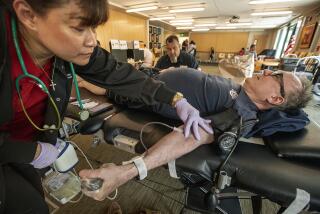Risk of Acquiring HIV From Transfusion Is Low
- Share via
Despite the publicity that has surrounded many AIDS blood transfusion cases, such as the infection that tennis star Arthur Ashe disclosed Wednesday, a contaminated transfusion is a relatively unusual means of contracting the human immunodeficiency virus.
Most of the infections, like Ashe’s, occurred before routine HIV screening of the blood supply began in the spring of 1985.
The risk of acquiring HIV from blood transfused in 1992 is very low, according to Dr. James W. Mosley, a professor of medicine at USC and the director of a federally funded study of blood transfusion safety.
Of the 213,641 AIDS cases documented in the United States as of February, 1992, 4,770, or less than 2.5%, were the result of blood transfusions, according to the U.S. Centers for Disease Control.
“The overall estimate is sometimes as high as one in 40,000 units of transfused blood,” Mosley said. “Other estimates go as low as one in 1 million units.” A typical blood transfusion involves two or three units of blood; each unit is about a pint.
Mosley said the risk varied somewhat among areas of the country. For example, it is probably higher in urban areas with large numbers of AIDS cases, such as Los Angeles or New York City, than it is in rural areas.
Greater public awareness of AIDS and greater sophistication among blood banks in discouraging at-risk individuals from donating blood has helped to increase the safety of the blood supply.
At a press conference, Ashe said he was “100% sure” that he contracted HIV through blood transfusions he received in New York City--either following open heart surgery in 1979 or again in 1983. Ashe said he was “95% sure” the infection occurred in 1983. He said he has known since 1988 that he has AIDS.
In 1983, federal health officials and blood bank directors began to discourage individuals at high risk of AIDS infection, such as homosexual men, from donating blood. But such voluntary efforts were far less effective in protecting the blood supply than the blood test for AIDS antibodies, which was introduced in 1985.
More to Read
Sign up for Essential California
The most important California stories and recommendations in your inbox every morning.
You may occasionally receive promotional content from the Los Angeles Times.












